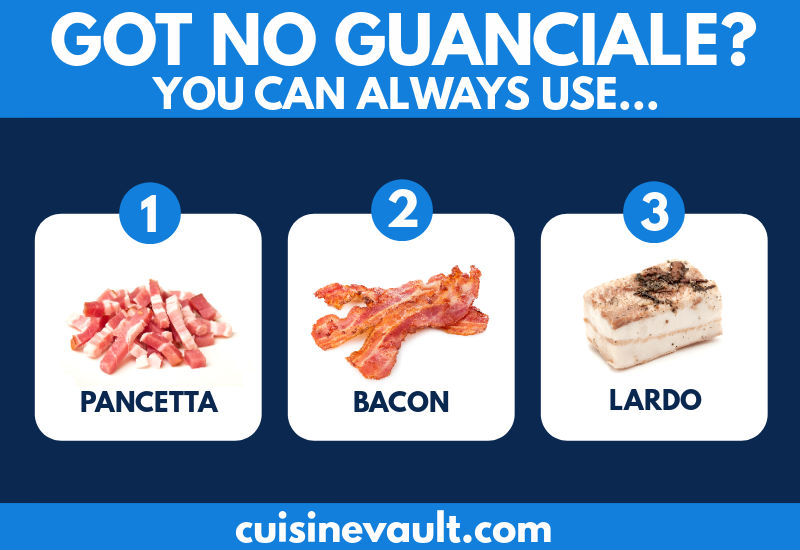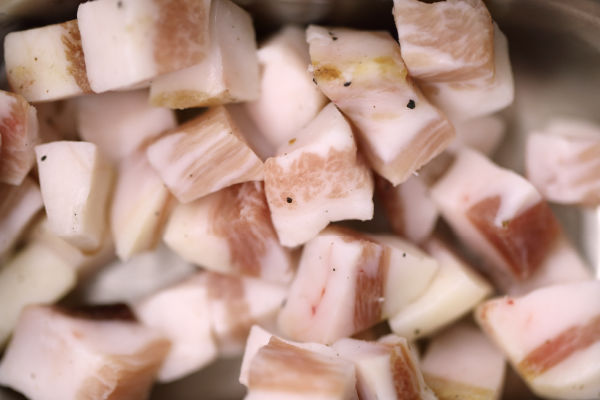Guanciale is a rich and flavorsome Italian cured meat made from pork cheeks. It has a high proportion of fat which melts into its surrounding ingredients when cooked, adding amazing depth of flavor. Classic sauces like sugo all'amatriciana and soul-warming dishes such as spaghetti alla carbonara both taste delicious with this flavorsome meat added.
Sourcing guanciale in the United States and many other parts of the world outside of Italy can be a challenge. If you're unable to find any, it doesn’t mean you can’t finish that authentic Italian recipe. What you need is a guanciale substitute that’s readily available in stores. We’ve pulled together our favorite alternatives, so let’s get started and find out what you can use.
The top 5 substitutes for guanciale
1. Pancetta
Pancetta is a cured Italian bacon that can be used as a guanciale replacement. Although its cut of meat is from the belly, the preparation is quite similar, resulting in a comparable product.
Traditionally, pancetta is aged for up to 4 months with herbs and salt, before being consumed. However, it is much quicker to pick up this meat from the supermarket. It is often sold in cubed form, making it easy to toss into a wide variety of recipes. Soup, casserole, and tagliatelle ala ragù bianco all gain delicious flavor from the addition of pancetta.
Note: Pancetta doesn’t have the strong pork flavor that guanciale does and its texture isn’t as delicate.
Related article:
Find out what the difference is between pancetta and prosciutto.
2. Bacon
When you're looking to mimic guanciale the best choice of meats should be cured without smoking. Choose unsmoked bacon and you’ll have a useful replacement option, even if its cure is likely to be sweeter.
If all you’ve got is smoked bacon, you can still use it. Simply blanch the rashers in boiling water for 1-2 minutes. This will remove much of the smoky, salty flavor. After rinsing, drain and then use a paper towel to pat dry to avoid oil spatter when adding it to the pan.
Bacon is delicious wrapped around chicken, baked in a casserole, or served alongside eggs for breakfast. When compared to guanciale, you’ll notice it has less fat and a less pronounced pork flavor. The other main difference is that squares of guanciale puff up when fried, providing a mouth-watering combination of crispy, chewy texture. Bacon is all crispiness when cooked.
Related articles:
How many slices of bacon in a pound?
In what way does pork belly and bacon differ?
3. Lardo
Lardo is a great guanciale alternative if you’re using it to render down the fat. It offers a much more subtle pork flavor and has a buttery texture that adds rich umami taste to foods like pizza, bread, potatoes, pastry, or steak. It can also be thinly sliced and eaten raw - the pieces melt in your mouth, and provide a subtle herbaceous undertone.
4. Pork jowl
The pork jowl is from the same part of the pig that guanciale comes from and is usually salt-cured, so they have similar characteristics. It is much fattier than pancetta and is a good option if you need to render fat for a sauce like al amatriciana. This meat is high in sodium so reduce the salt in the rest of your recipe to avoid an unbalanced, salty meal.
In the supermarket, you’ll find pork jowls in the bacon section and it is relatively inexpensive.
5. Salt pork
Salt pork is an economical fresh meat option that isn’t as salty as the name suggests. It usually comes from the pork belly and looks a lot like slab bacon. The main difference is that salt pork is fattier than bacon, and it is never smoked. If you decide to use this option then remember to rinse it well to reduce the “salt factor”.

Receommended guanciale alternatives.
Fast facts about guanciale
- It is a central Italian specialty, revered in Lazio and Umbria.
- To make it, pork cheek is commonly combined with thyme, fennel, garlic, red pepper, and then cured until the meat reduces its weight by 30%. This process takes about 3 weeks.
- Guanciale is a popular adddition to tagliatelle con guanciale e zucca, pasta alla gricia, strozzapreti, and pecorino romano e guanciale
- Its name derives from guancia which means “cheek” in Italian – a reference to the use of pork jowls (cheeks).
- The FDA had preciously banned imports of guanciale into the United States which made it more difficult to source in shops. However it has since been lifted, making salami from Europe more accessible. Source.

Pasta with guanciale added.
Related reading:
What is a useful substitute for mortadella?
What are the best nduja alternatives?
What is old world pepperoni?
Summing up
Guanciale has a robust pork taste and, with its high-fat content, adds delicious flavor and texture to recipes. Many Italians believe it is one of the highest quality meats you can get. However, in the United States, it isn’t easily found and when you eventually discover some, it is generally very expensive. For many of us, a handy substitute is the best option to finish that Italian recipe.

Cubes of guanciale ready to cook.
The biggest challenge to sourcing a replacement for guanciale is finding a meat that hasn’t been smoked. This added flavor will put many classical recipes out of balance and may not be appropriate for every cooking option. Pancetta, bacon, lardo, pork jowl, and salt pork are all excellent options. They won’t perfectly mimic the flavor and texture of guanciale, but they’ll still taste delicious in most dishes.
Have you tasted guanciale? What do you think of its taste? Please let us know in the comments below.

Leave a Reply